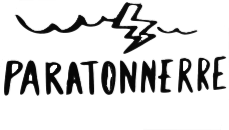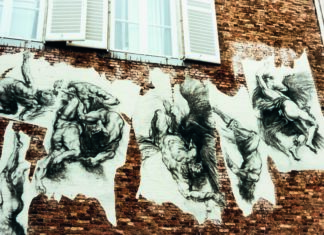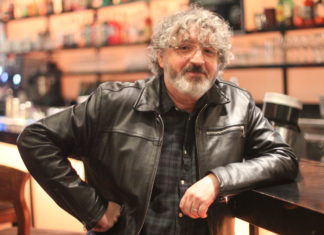Témoignage : la théière et le bocal : Les origines du livre « Abattoir 5 »
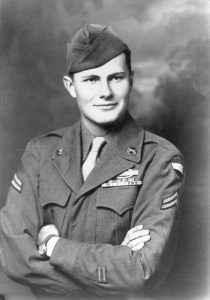 Gifford Doxsee, vétéran américain et professeur d’Histoire retraité de l’Université de l’Ohio fut prisonnier de guerre dans un camp allemand à Dresde à la fin de la Seconde Guerre mondiale. Cantonné à l’abattoir numéro 5 avec entre autres, Kurt Vonnegut, célèbre écrivain, auteur du livre semi-biographique et de science-fiction « Abattoir 5 » (1969). Doxsee a raconté que Vonnegut, plus grand du groupe de prisonniers, servait d’interprète entre les détenus américains et leurs gardes allemands.
Gifford Doxsee, vétéran américain et professeur d’Histoire retraité de l’Université de l’Ohio fut prisonnier de guerre dans un camp allemand à Dresde à la fin de la Seconde Guerre mondiale. Cantonné à l’abattoir numéro 5 avec entre autres, Kurt Vonnegut, célèbre écrivain, auteur du livre semi-biographique et de science-fiction « Abattoir 5 » (1969). Doxsee a raconté que Vonnegut, plus grand du groupe de prisonniers, servait d’interprète entre les détenus américains et leurs gardes allemands.
« Dans le célèbre roman de Science-fiction “Abattoir 5” (1969) de Kurt Vonnegut inspiré de son expérience de prisonnier américain durant la Seconde Guerre mondiale, il y a un épisode où Edgar Derby est fusillé par les SS pour avoir volé une théière dans les décombres d’une maison. En réalité, il n’y a jamais eu de théière ni d’Edgar Derby. Cependant, il y avait un prisonnier de guerre appelé Michael Palaia, Italo-américain de Philadelphie. Un jour, alors que nous étions de nettoyer les décombres après un bombardement, Michael est rentré dans la cave et a trouvé un bocal d’haricots verts. Nos gardes allemands nous avaient prévenus que nous pouvions manger dans les caves mais aucunement des aliments que nous aurions pu trouver dans les décombres. Prendre toute chose d’un bâtiment bombardé était considéré en temps de guerre à du pillage par les lois internationales. Le vol pouvait être passible de la peine de mort.
Michael a caché le bocal dans sa poche de veste et la ramener au lager (là où nous dormions). Il a mangé les haricots plus tard dans la nuit alors que nous dormions tous. Michael aurait pu éviter tout problème s’il n’avait pas escaladé le tas de gravats dans la cour. Des SS avaient décidé d’inspecter les lieux à ce moment-là. Et un des soldats a vu que Michael avait quelque chose dans sa veste et il trouva les haricots. De plus, Michael était un récidiviste. Le lendemain matin, à l’appel des prisonniers, il fut embarqué. Plusieurs jours plus tard, quatre autres prisonniers, au moment de l’appel, furent eux aussi exclus du camp mais ils revinrent en fin de journée. Ils nous ont raconté qu’ils avaient creusé la tombe de Michael et il fut enterré après l’exécution perpétrée par les SS. Sa mort était le plus gros événement que nous avons eu depuis nos 5 mois de détention en tant que prisonnier de guerre.
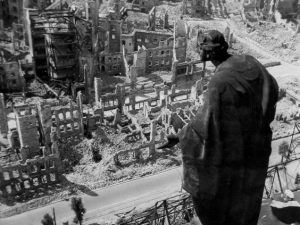
Cette histoire a une incroyable suite. Le fils d’un autre prisonnier de guerre qui était avec nous à Dresde décida de retrouver possible des 150 anciens prisonniers qui étaient internés là. Il voulait nous interroger et écrire un livre et retrouva le frère cadet de Michael. 50 ans après la fin de la guerre, en 1995, il appela le frère et celui-ci demanda alors : « Allez-vous enfin de me raconter les circonstances de la mort de Michael ? ». La famille n’avait jamais appris ce qui était arrivé, où, quand et comment il était mort. L’auteur me contacta à ce sujet. J’ai téléphoné au frère de Michael et je lui ai raconté l’histoire du vol. La famille n’avait reçu qu’un télégramme indiquant que Michael avait été porté disparu. Le même message que mes parents avaient reçu me concernant. Mais les Palaia n’ont depuis rien reçu de nouvelles du fils. Le jour de l’anniversaire de Michael, le lundi 7 mai 1945, sa mère (Catholique italienne dévouée) décida de savoir si son fils était vivant ou non. Elle alla dans sa chambre et pria la Vierge Marie afin d’avoir une réponse. Le frère de Michael aurait dû aller à l’école mais il ne sentait pas bien et sa mère lui avait alors permis de rester à la maison. Dans l’après-midi, il resta sur le canapé, ne sachant ce que sa mère faisait dans sa chambre. Soudain, il y eut un coup de vent qui ouvrit la porte de la maison. Une photo de Michael posée sur une table se mit à tomber et le verre qui protégeait le portrait se brisa. Quand Madame Palaia entendit le bruit, elle descendit et vu la photo sur le sol. Elle se mit à hurler. Son fils tenta de la rassurer et promis d’acheter un nouveau cadre. “Tu ne comprends pas, dit sa mère. C’est la preuve que Michael ne reviendra pas à la maison.
Cette histoire me fait toujours pleurer chaque fois que je la raconte. Je n’aurais cru que tant d’années plus tard, je puisse être encore aussi ému. »
Gifford B. Doxsee a survécu au terrible bombardement de Dresde (Février 1945) et après la guerre enseigna l’Histoire européenne et du Moyen-Orient à l’Université de l’Ohio entre 1958 et 1994. Il y vit toujours à proximité dans la ville d’Athens.
Testimony: The teapot & the jar: the origins of ‘Slaughterhouse 5’
 Gifford Doxsee, a U.S. Army veteran and former Ohio University Professor of History, was about his time a Prisoner Of War in a German camp in the later days of World War II. Doxsee was held in Slaughterhouse Five alongside fellow soldier Kurt Vonnegut, the famous American author of the best-novelist ‘Slaughterhouse 5 or The Children’s Crusade: A Duty-Dance with Death’ (1969). Doxsee said Vonnegut, the tallest man in the group, served as an interpreter between the Americans and the Nazi captors.
Gifford Doxsee, a U.S. Army veteran and former Ohio University Professor of History, was about his time a Prisoner Of War in a German camp in the later days of World War II. Doxsee was held in Slaughterhouse Five alongside fellow soldier Kurt Vonnegut, the famous American author of the best-novelist ‘Slaughterhouse 5 or The Children’s Crusade: A Duty-Dance with Death’ (1969). Doxsee said Vonnegut, the tallest man in the group, served as an interpreter between the Americans and the Nazi captors.
« In the science-fiction novel ‘Slaughterhouse-Five’, by Kurt Vonegut Jr. (from his time as an American soldier), there is a famous episode in which Edgar Derby is shot by the SS for stealing a teapot from
the cellar of a bombed house. In reality, there was no teapot and there was
no Edgar Derby. However, there was a POW in our group named Michael Palaia, an Italian-American lad from Philadelphia. One day as we were cleaning up rubble from the bombing, he went into a cellar and found an unopened jar of string beans. Our German guards had indicated that we might eat food in the cellars, provided that we did not take anything out of the building.Taking Anything from a bombed building in wartime is defined as looting by international law, and looting is punishable by death. Michael figured that he could hide the jar in the pocket of his field jacket, take it back to our lager (building where we slept), and eat it late at night after all the rest of us were asleep. He probably would have succeeded in this plan Except that as he was climbing over the pile of rubble from the courtyard to the street, there was an unexpected inspection
by units of the SS. One of those German soldiers saw the bulge in Michael’s field jacket, inspected the jacket, and found the string beans. Michael was
thus « a marked man. » Next morning at roll call, he was taken away. Several days later four other prisoners were also taken away during roll call, but they returned that evening to tell us that they had been forced to dig Michael’s grave and bury him after he was shot by the SS. Michael’s death was the single most memorable event in our five months as Prisoners of War.
 There is an amazing sequel to this story. A son of another Prisoner of War who was with us in Dresden. He decided to try to
There is an amazing sequel to this story. A son of another Prisoner of War who was with us in Dresden. He decided to try to
locate as many of our group of 150 POWs as possible. He wanted to interview many of us and write a book based on our collective memories. He located Ralph Palaia, a younger brother of Michael, who was still living in Philadelphia, Pennsylvania. At the very end of January, 1995 (fifty years after the end of World War Two), The son telephoned Ralph Palaia totell him about his book project and to ask Ralph if he’d be willing to provide family background on Michael. Ralph’s response was: « Are you telling me that you know the circumstances of my brother’s death? » The family had never learned where, when, or how Michael had died.
So I called Ralph Palaia at once and told him that I had
known his brother and could confirm the story of is death.
He then told me an even more dramatic story, as follows.
The parents of Michael and Ralph had received a telegram in early January 1945, from the War Department, telling them that Michael was missing in
action. This is the same message that my parents received at the same time.
The next word about me which my parents received (on April 11,
1945)consisted of two air letters I had written to them in early January.
The Palaia family had received no word whatever from Michael or the U. S. government. So on Michael’s twentieth birthday, May 7, 1945, Mrs. Palaia (who was a devout Italian-American Roman Catholic lady) decided to find out in her own way whether or not Michael was still alive. She went upstairs to her bedroom, closed the door, and prayed fervently to the Virgin Mary for a sign. May 7 was a Monday in 1945, and Ralph should have been in school. He had not felt well that morning, however, and his mother had permitted him to remain at home. In the middle of the afternoon he was resting downstairs on the couch in the living room. He knew his mother was in the house, but he had no idea what she was doing. Suddenly a gust of wind blew open the front door of the Palaia house. Inside the door was a table on which there was a photograph of Michael, enclosed in glass. The wind blew the photo to the floor, causing the glass to shatter. When Mrs. Palaia heard the noise, she called down to Ralph: « What was that? » When he told her,she screamed. He called back to her « It’s nothing, Mother. I’ll take the picture to the store and have the glass replaced. » She then called down to Ralph: « You do not understand. That was the sign which I prayed for. Michael will not be coming home. »
This story brings tears to my eyes each time I think about it or share it. I never would have believed in 1945 that stories such as this would be coming to me fifty years after the end of the War. This helps to explain why the memories of the Second World War remain so vivid for me even to the present day. »
Gifford B. Doxsee survived the tremendous Dresden firebombing (february 1945) then after the war, taught both European and Middle Eastern history are what landed him a history professorship at Ohio University from 1958 to 1994. He still lives in Athens.
